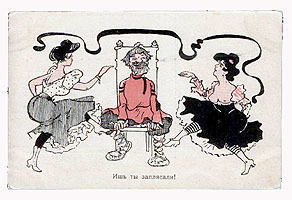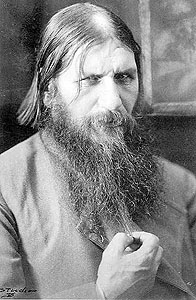
Satirical 1905 postcard


Rasputin
Grigorii Rasputin was born in a Siberian village along the Tura River a long way from St. Petersburg. There still remains a lot of uncertainly about his birth and childhood. He eventually chose for himself the life of a religious wanderer or pilgrim, a starets (ста́рец), and he claimed to be a psychic and faith healer.
In 1903 he arrived in St. Petersburg. This proved an opportune time for him. On 30 July 1904, the tsar and his wife gave birth to a little boy, Aleksei, who proved to be afflicted with hemophilia. Eventually, the family asked for Rasputin's help in controlling the disease, and supposedly there were documented incidents when Rasputin was able to help the boy's bleeding attacks.
Rasputin became a scandalous figure, cavorting with his female followers from high society (and also cavorting with his female followers from the lower classes)--There is no doubt about it, Rasputin loved cavorting with any female followers all of the time, any time, everywhere. He was always drinking, and not very attentive to elements of his personal hygiene.
When tsar Nicholas II left Petrograd in 1915 to take personal command of the Russian army, he left behind in the capital Aleksandra and Rasputin to basically run the government. That proved to be a disaster as the government's ministers were constantly replaced as they fell in and then out of favor with Rasputin.
Some of the imperial family and other members of high society eventually decided that Rasputin had to go for the good of Russia. On 16 December 1916, Prince Feliks Iusupov, V. M. Purishkevich and Grand Duke Dmitrii Pavlovich and others lured the "mad monk" (Rasputin) to the Iusupov palace with the promise of cavorting with women and some food and drink. And so the legend goes:
"Rasputin however, didn't die easily. First, he resisted being poisoned with Cyanide, then he was shot at close range. Left for dead, he recovered, and attempted escape. He was then shot repeatedly, and, in a what was probably a fit of rage on the part of Felix, beaten savagely about the head with a dumb-bell handle. Rasputin was then bound, driven to the Malaya Nevka river and thrown in through a hole in the ice. It is in these freezing waters that Rasputin met his demise - when the body was recovered it became clear that even by the time he was thrown into the water, Rasputin was not dead, but still alive and was desperately attempting to free himself from his bonds and escape. The body was finally recovered from the river by the Great Petrovsky Bridge. During the autopsy on the 20th December, Rasputin's heart was removed, and was stored at the Academy of Military Medicine until its mysterious disappearance during the 1930's. The rest of the body was buried the next day. However, the grave was later reopened and the body removed. It was taken from Tsarskoe Selo to Petrograd, then again out onto the Vyborg highway in order for a secret burial, but the car became stuck, and so the the body was incinerated on a hastily created pyre at the side of the road. The ashes were scattered."
A nice story, but is it true? See, en.wikipedia.org/wiki/Rasputin (an excellent starting point for information on Rasputin and his murder) and then Rasputin assassinated by British Secret Service--BBC Timewatch documentary.
There is a lot of sensational trash about Rasputin on the web, but see:
- Rasputin biography
- The Evil Monk: The life and times of Gregory Efimovich Rasputin
- The Home of Rasputin
- Grigory Rasputin, Poet, Magician, Healer, Prophet, Holy Monk.
- www.rotten.com/library/bio/historical/rasputin/, read this with some attention
- The Murder of Rasputin
- Rasputin, Grigori Efimovich